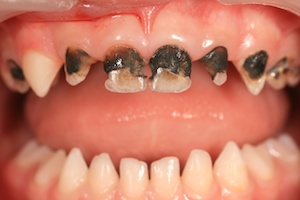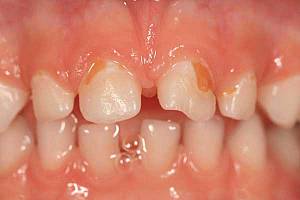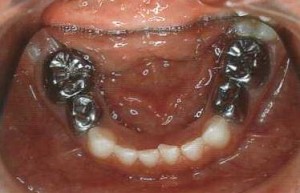Crowns on baby teeth

Crowns for dairy teeth in children are used to preserve and restore damaged teeth.
If a child has tooth decay and there is a pulp lesion, then the best way to protect and preserve the tooth until its physiological loss is to fix the tooth crown on it.
Studies by dentists have shown that the life of glass ionomer cements and composites on milk teeth is short and until the teeth are permanent, such fillings have to be replaced more than once.
It will be more effective to protect the affected tooth from destruction by the crown.
Crowns for primary teeth are:
- Temporary, which are used to protect the pulp on non-carious teeth (for example, in the presence of chips) or to strengthen fixed orthodontic structures.
- Permanent crowns are used to protect the tooth from decay by caries.
Benefits
- They allow you to save milk teeth until the moment of physiological replacement for permanent.
- Restore the functionality of damaged teeth.
- Prevent the violation of diction.
- Crown restoration stimulates the growth of jaw bones, which is important in the process of forming the correct bite and alignment of the dentition in the future.
- Restores the aesthetics of a smile.
When install
Crown restoration is considered necessary:

- If caries has destroyed the deciduous tooth by more than half.
- In violation of the development of enamel.
- If a tooth injury occurs (root fracture, crown cleavage).
- In the presence of actively developing caries.
- If tooth pulp is removed.
- With complete destruction of the dental crown.
- If there is a cosmetic defect. Especially on the front teeth.
- With fluorous tooth decay.
Features of prosthetics of primary teeth
To fix the crowns in children, tooth grinding is very rare.
Only if there is a need to reduce the height of the bite.
The absence of the preparation stage has a positive effect on the psyche of the child, in addition, as a result, the strongest part of the tooth is preserved - enamel.
Types of crowns
- Metal structures are the most common. They are made of nickel-chrome alloy or stainless steel. Currently, the alloy of nickel with chromium is the best for the restoration of milk teeth.
- Strip-crowns (strip-crowns). They are used for prosthetics of the frontal group of teeth.
Metal crowns

Metal dental structures for primary teeth are not made according to casts, as in adults.
There are special sets of crowns that the dentist can choose according to the size and shape of the tooth.
The advantages of prosthetics with metal crowns of milk teeth are that the installation of the crown is possible in one medical appointment, which ensures maximum comfort for the child.
Disadvantages of metal crowns
- The use of metal crowns is optimal for prosthetics of molars, however, their restoration of the front teeth will be unaesthetic.
- In some children, an allergic reaction may occur to nickel, which is part of the structures.
Indications
- Strong destruction of the crown part of the molars.
- Restoration of teeth with defects.
- Protection and restoration of teeth from severe decay by caries.
- Dental restoration after a fracture.
- Hypoplasia of the molars.
Strip crowns

Strip crowns are widely used in pediatric dental prosthetics.
This method became possible with the advent of acrylic structures and light-cured composites on the market.
This method is considered the most effective, fastest and technologically simple.
After installing the crowns after six months, it will be necessary to re-visit the dentist in order to exclude a relapse of caries.
A strip crown is a celluloid cap. Designs are made in the form of a set of 16 sizes for each jaw.
Indications
- Malformations of milk incisors.
- Damage to the enamel surface of the anterior deciduous tooth.
- Changing the color of the enamel of the anterior teeth.
- After an injury to the anterior deciduous teeth.
- Violation of amelogenesis.
How to install
Restoration is carried out under anesthesia and takes no more than 20 minutes.
- Before installing the crown, plaque and all tissues affected by caries are removed, after which the tooth is shortened by 0.5 mm.
- Strip-crown, filled with composite and fixation on the prepared tooth.
- Then, under the influence of light, the composite is polymerized.
- After polymerization, the cap is removed from the tooth.
- The restored tooth crown is ground and polished.
- Then, re-polymerization is carried out on each side of the restoration for 40 seconds.
Reviews
Parents of children who have crowns on baby teeth have left mostly positive reviews.
Here is some of them:
- My son broke two front teeth during a fall. Yesterday they put caps on them. They look like real teeth. Before restoring the teeth, the dentist anesthetized, cleaned the canals, sealed, and then put on the caps.
- A year ago, a child fell off his bicycle and damaged his front tooth. Tooth split in half along. The doctor installed a strip crown that holds well and looks aesthetically pleasing.
- Six months ago, the daughter of the crown was installed. Before that, they went to the doctor every one and a half to two months to put in seals that did not want to stay at all. Putting crowns is not a problem, in thirty minutes the dentist put two crowns. The daughter easily underwent the procedure. Crowns have been standing for six months.